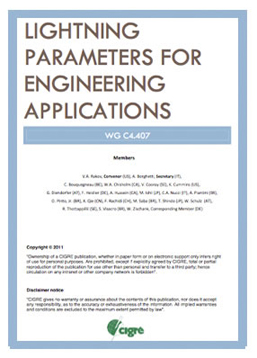TEN350 The waveform that hijacked the IEC lightning standards
CIGRE invalidates validity of 10/350 lightning parameters

10/350 PARAMETERS: THE REST OF THE STORY
As is shown elsewhere on this web, the "10/350 waveform" has been a bit of a misnomer since it always comes packaged up with 3 other components that IEC lightning protection standards insisted were all derived from those 2 earlier CIGRE articles.
See extract from Table 3 of IEC 62305-1. This data appears in every IEC lightning standard. The parameters include: Peak Current: 200kA; Time to current peak: T1=10μs; Length of wavetail: T2= 350μs; Charge (Q) = 100 Coulombs; Specific Energy (W/R) = 10 MJ/Ω.
THE FOLLOWING FINDINGS FROM CIGRE'S 2013 TECHNICAL BROCHURE 549 PERTAIN TO THOSE 5 PARAMETERS:

Peak Current: 200kA. The CIGRE 2013 report suggests for 99% worst-case scenario of positive lightning: Ipeak = 350kA.
Did the CIGRE report comment any further on that? Yes, in Section 3.1 states that "particularly the extremely high (greater than 100kA or so) peak current tails require much larger sample sizes...than presently available (or to be available in the foreseeable future) to bring the uncertainties within an engineering accuracy range." Thus, for engineering purposes, the report discourages inferring any correlation from Berger's data between positive CG high peak currents (over 100kA) and long 350μs wave tails.
Did CIGRE's 2013 report suggest why the Berger figures showed a few positive lightning flashes with a tail as long as 350 microseconds? Yes it did. Section 7.4 (Current Waveform Parameters) explains that those long tails were likely coming from M-components i.e. additional surges in the continuing currents, not part of the impulse of a return stroke.
Did CIGRE's 2013 report find any recent instances of a lightning waveform where the tail was 350 microseconds long? No, none were mentioned. Click here to see the findings of modern researchers.
Did CIGRE's 2013 report iterate a more realistic figure of the duration of the tail of a lightning flash? Yes it did. Sect. 7.4 Current Waveform Parameters suggests Gamerota et al's recommendation for the worst case 1% scenario of positive return strokes, current peak 350kA and time to decay to half peak of 40μs.
Did CIGRE comment on the accuracy of Berger's directly measured positive lightning currents on which the 10/350 waveform was based? Yes, the report states the following: Berger's "positive current waveforms that have very large peaks (many in excess of 100kA) ... (Berger et. al. 1975) are likely to be the result of M-component mode of charge transfer to ground." Section 2.3 of the report explains that M-components are not part of the waveshape of the initial short stroke, but rather additional surges in the "continuing currents" of some lightning flashes. Berger's sample of 26 positive lighting currents was contaminated due to being a mixture of these two different types of discharges.
For 30 years we have been told that these long 350-500 µs tails were coming from Berger's findings on positive lighting and consequently MUST to be included in IEC lightning protection standards for engineering applications. Did CIGRE comment on that? Yes, they did. The report warns in about sixteen different places against placing credence in those parameters. These so-called "parameters of positive lightning" are (and have always been) statistically insignificant. The CIGRE warnings can be found in the previous page of this series.
IEC 62305 series says those positive long wave tails came from Berger in CIGRE Electra 41. Is that true? TC 81 cites Berger and the 2 Electra articles as the sole source of the data that has given authority to the 350µs-long-tailed waveshape that was made the cornerstone of IEC 62305. Berger included 4 “positive lightning” waveforms in Electra 41 with the caveat that they did “not have enough common features to produce an acceptable mean current shape.” He also mentioned that this was partly due to the fact that there were so few (only 21) positive strokes reported in that period. Shortly thereafter, he discovered his positive CG lightning sample had been contaminated with upward lightning flashes. More recently, the CIGRE 2013 report has shown that the same sample was found to be further flawed by reason of mixing CC waveforms in with the microsecond impulse waveforms and SIXTEEN TIMES cautions the reader against placing too much import upon them for engineering purposes. For these reasons, none of the “positive lightning parameters” IEC standards have imputed from Berger's data can be considered statistically significant for engineering applications.
Charge transferred--Q = 100 coulombs: This parameter is almost always mentioned together with peak current and length of the tail. It is the basis of the 62305 lightning model, its Class I test, the Lightning Protection Zone (LPZ) and Lightning Protection Levels (LPL) systems. IEC 62305-1 A.3.1 would have you believe that the 350-microsecond wavetail was derived from the peak current and charge transfer. In fact, it is more likely that the "charge" was computed based on a 200 kA current and 500μs length of wavetail. But since none of those five parameters have any basis in reality or in science it makes little difference. The CIGRE 2013 report says those high charge transfer figures were coming from continuing currents. Its Conclusion #3 cites Table 3.6 as "recommended lightning current waveshape." That table gives as medium stroke charge: "4.65 Coulombs."
Not mentioned in the CIGRE report, but worthy of mention here is the fact that the 200 kA peak current, the 350-500 microsecond length of tail and the 100 coulombs charge all originate in the Hasse 10/350 chart here.
As shown elsewhere on this web, these parameters didn't originate from Berger anyway. They came from Dr. Peter Hasse.
ADDITIONAL CIGRE FINDINGS THAT NEED TO BE CONSIDERED IN FUTURE LIGHTNING STANDARDS:
1) 5% of negative CG >100kA. 20% of positive CG >100kA. Highest measured negative stroke - 200kA; highest measured positive stroke = 300kA
2) 80% or more of CG flashes are composed of 2 or more strokes. The average number of strokes per negative flash is 3 -5 with interstroke interval of 60 ms. This is far greater than the 55% originally perceived by Berger. This may be the single most common trait amongst all lightning parameters.
3) First stroke current peaks are typically 2-3 times larger than subsequent strokes BUT over 1/3 of CG flashes have at least one subsequent stroke with peak current higher than the first stroke peak. The report notes that these larger-than-first subsequent strokes may represent an additional threat to power lines and other systems. "This relatively high percentage suggests that such flashes are not unusual, contrary to the implication of most lightning protection and lightning test standards."
4) The CIGRE 2013 TB 549 found that the highest positive strike ever directly measured was 300kA. The highest negative was 200kA. Remote detection systems have inferred strikes of 500kA.
5) As for length of tail, the CIGRE report invalidates the 350-microsecond wavetail of positive lightning. For time to decay of half peak the CIGRE report cites Gamerota's recommended 40μs.